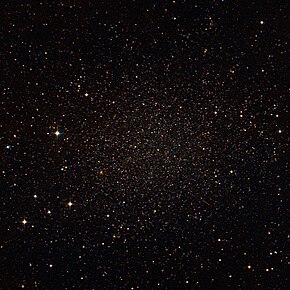
Back Sculptor-dwergsterrestelsel Afrikaans مجرة النحات القزمة Arabic Nana de l'Escultor Catalan Sculptor-Zwerggalaxie German Enana de Sculptor Spanish Kuvanveistäjän kääpiögalaksi Finnish Galaxie naine du Sculpteur French הגלקסיה הננסית פסל HE Galassia Nana dello Scultore Italian ちょうこくしつ座矮小銀河 Japanese
| Sculptor Dwarf Elliptical Galaxy | |
|---|---|
 | |
| Observation data (J2000 epoch) | |
| Constellation | Sculptor |
| Right ascension | 01h 00m 09.3s[1] |
| Declination | −33° 42′ 33″[1] |
| Redshift | 110 ± 1 km/s[1] |
| Distance | 290 ± 30 kly (90 ± 10 kpc)[2][3] |
| Apparent magnitude (V) | 10.1[1] |
| Characteristics | |
| Type | E[1] |
| Apparent size (V) | 39′.8 × 30′.9[1] |
| Other designations | |
| Sculptor Dwarf Spheroidal,[1] PGC 3589,[1] MCG-06-03-015, ESO 351-30[4] | |
The Sculptor Dwarf Galaxy (also known as Sculptor Dwarf Elliptical Galaxy or the Sculptor Dwarf Spheroidal Galaxy, and formerly as the Sculptor System) is a dwarf spheroidal galaxy that is a satellite of the Milky Way. The galaxy lies within the constellation Sculptor. It was discovered in 1937 by American astronomer Harlow Shapley using the 24-inch Bruce refractor at Boyden Observatory.[5][6] The galaxy is located about 290,000 light-years away from the Solar System. The Sculptor Dwarf contains only 4 percent of the carbon and other heavy elements in our own galaxy, the Milky Way, making it similar to primitive galaxies seen at the edge of the universe.[7]
- ^ a b c d e f g h "NASA/IPAC Extragalactic Database". Results for PGC 3589. Retrieved 2006-12-03.
- ^ I. D. Karachentsev; V. E. Karachentseva; W. K. Hutchmeier; D. I. Makarov (2004). "A Catalog of Neighboring Galaxies". Astronomical Journal (abstract). 128 (4): 2031–2068. Bibcode:2004AJ....127.2031K. doi:10.1086/382905.
- ^ Karachentsev, I. D.; Kashibadze, O. G. (2006). "Masses of the local group and of the M81 group estimated from distortions in the local velocity field". Astrophysics. 49 (1): 3–18. Bibcode:2006Ap.....49....3K. doi:10.1007/s10511-006-0002-6. S2CID 120973010.
- ^ Stoyan, Ronald; Schurig, Stephan (2014). interstellarum Deep Sky Atlas. Erlangen: Cambridge University Press; Oculum-Verlag GmbH. ISBN 978-1-107-50338-0. OCLC 920437579.
- ^ Shapley, H. (1938). "A Stellar System of a New Type". Harvard College Observatory Bulletin. 908: 1–11.
- ^ Shapley H (1938). "Two Stellar Systems of a New Kind". Nature. 142 (3598): 715–6. Bibcode:1938Natur.142..715S. doi:10.1038/142715b0. S2CID 4071472.
- ^ Astronomers Detect Dust Around a Primitive Star, Shedding New Light on Universe’s Origins Newswise, Retrieved on January 19, 2008.
© MMXXIII Rich X Search. We shall prevail. All rights reserved. Rich X Search